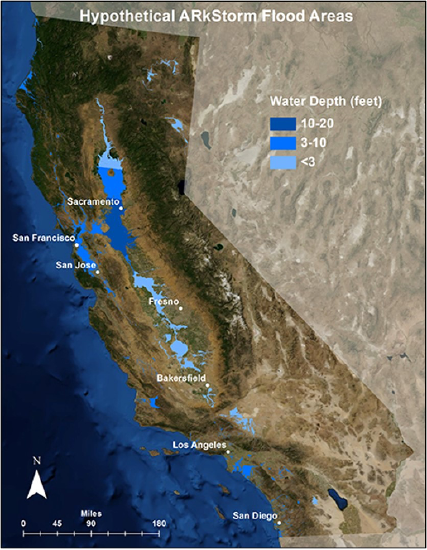9.5: Activity 9D- The Great Flood of California (1862)
- Page ID
- 14825
In the winter of 1861-62, rain across the West created the worst flooding in the history of California, Oregon, and Nevada, killing thousands, more than 1% of the population at the time, and bankrupting the state. A 300-mile stretch of California’s Central Valley, the center of its agriculture, was covered thirty feet deep in water. Yet most Californian’s have never heard of it. (The Big Ones, L. Jones, 2018).

Unfortunately, due to climate change, storms of this magnitude will become more frequent and intense. To prepare communities the USGS developed a simulation, ARkStorm, to address these massive storms (Figure 9.18). Experts from scientific research agencies were assembled and tasked with designing a large, but scientifically plausible, hypothetical storm scenario that hit both northern and southern California. The wind, precipitation, flooding, and coastal hazards were translated into physical, environmental, social, and economic damages to provide emergency responders, resource managers, and the public a realistic assessment of what is historically possible.
1. Watch this USGS video on the Great Flood and ARkStorm simulation.
2. Should the Great Flood occur again, today, what ramifications and impacts would affect our communities and state?
a. What areas would be affected most? Why?
b. What industries would be affected?
c. Would this affect anyone beyond California, why or why not?
3. The video asks an important question: how will society deal with the social, economic and environmental impacts from a flood of this magnitude? The ARkStorm simulation was developed to give scientists and communities the opportunity to begin planning and preparing for this future event. After all, natural hazards are only hazards because of humans. Hazard science tries to understand the hazard and develop action plans to reduce the impact on us. In your opinion, what can we do proactively to reduce our future hazard potential when it comes to a flood of this magnitude?
4. Want to know more about the Great Flood and ARkStorm? Consider reading these,
a. Mother Jones: The Biblical Flood That Will Drown California (2020)
b. Scientific American: The Coming Megafloods (2013)
Attributions
- Figure 9.18: “ARkStorm” (Public Domain; USGS via Wikimedia Commons)


